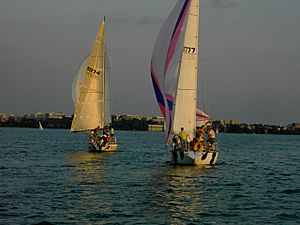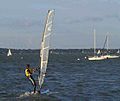Lake Mendota facts for kids
Quick facts for kids Lake Mendota |
|
|---|---|

Boats headed toward south shore (downtown Madison).
|
|
| Location | Dane County, Wisconsin, United States |
| Coordinates | 43°06′24″N 89°25′29″W / 43.10667°N 89.42472°W |
| Type | Natural freshwater lake |
| Primary inflows | Yahara River |
| Primary outflows | Yahara River |
| Catchment area | 562 km2 (217 sq mi) |
| Basin countries | United States |
| Max. length | 5.62 mi (9.04 km) |
| Max. width | 4.11 mi (6.61 km) |
| Surface area | 9,740 acres (3,940 ha) (39.4 sq. km) |
| Average depth | 12.8 m (42 ft) |
| Max. depth | 25.3 m (83 ft) |
| Water volume | 500 million cubic metres (18×109 cu ft) |
| Residence time | 4.5 years |
| Shore length1 | 21.6 mi (34.8 km) |
| Surface elevation | 259 m (850 ft) |
| Frozen | December 20 (average freezing date) |
| Settlements | Madison, Middleton, Shorewood Hills, Maple Bluff, Westport |
| 1 Shore length is not a well-defined measure. | |
Lake Mendota is the biggest and northernmost of the four lakes in Madison, Wisconsin. It's a natural freshwater lake. The lake touches Madison on its north, east, and south sides. It also borders other towns like Middleton, Shorewood Hills, Maple Bluff, and Westport.
Contents
Exploring Lake Mendota's Surroundings
Lake Mendota and Lake Monona are separated by a narrow strip of land called an isthmus. This land is where much of Madison, Wisconsin, is located. Even though they are separated by land, the lakes are connected by the Yahara River.
The areas around Lake Mendota have many different things to see. You'll find beautiful homes, but also natural areas and parks. One popular spot is James Madison Park. There are also university buildings, like the UW Student Union, and some hotels and restaurants.
Fun Activities on the Lake
In summer, Lake Mendota is a busy place for boaters, especially on weekends. It's a great spot for many water sports. You can go fishing, water-skiing, wakeboarding, tubing, canoeing, wind-surfing, kayaking, and sailing.
When winter arrives, usually around December 20, the lake freezes over. This turns it into a giant playground for winter sports. People enjoy ice-boating, ice-skating, ice fishing, cross country skiing, ice hockey, and snowkiting.
University Life by the Lake
The University of Wisconsin–Madison campus is located along the southern shore of Lake Mendota. In the early 1900s, scientists Chancey Juday and Edward A. Birge started an important study center here. This center focuses on limnology, which is the study of freshwater lakes and rivers. The university's Hoofer Sailing Club also operates right on the lake at Memorial Union.
Beaches for Swimming and Fun
The city of Madison has five beaches along Lake Mendota. Three of these beaches have lifeguards to keep everyone safe while swimming.
Studying Lake Mendota
Lake Mendota is one of the most studied lakes in the United States. The UW–Madison Center for limnology is right on its southern bank. Scientists use a special remote sensor buoy, nicknamed David Buoy, to collect data. This buoy is part of a larger network that studies lakes around the world.
The lake has a surface area of about 3,988 hectares (about 9,854 acres). Its deepest point is 24.9 meters (about 82 feet). The water's pH level is usually between 8.3 and 8.4.
In 2009, a tiny invasive creature called the spiny water flea (Bythotrephes longimanus) was found in the lake. This was an important discovery for scientists studying the lake's ecosystem.
Images for kids
-
Lake Mendota viewed from the steps of the Memorial Union








